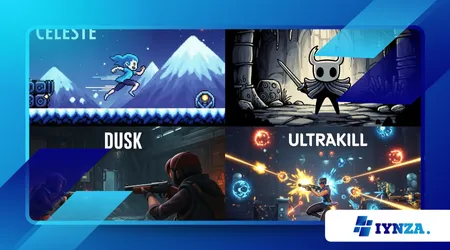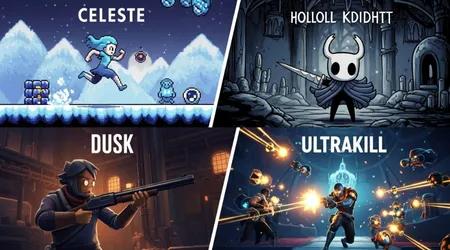Best Indie Games for Speedrunning Enthusiasts

Best Indie Games for Speedrunning Enthusiasts define a perfect synergy between masterful game design and the competitive spirit.
Anúncios
The independent scene consistently delivers titles that, while appearing simple, possess an incredible depth of mechanics, sequence breaks, and complex execution.
This is where the world-class speedrunning community thrives, constantly pushing the limits of what seems possible.
Gone are the days when only AAA titles commanded global speedrunning attention.
Today’s indie games are often deliberately crafted with speed, optimization, and intricate player movement in mind, providing the necessary foundations for high-level competitive play.
Anúncios
We explore the essential titles that any dedicated speedrunner must master in 2025.
Why Do Precision Platformers Lead the Best Indie Games for Speedrunning Enthusiasts?
Precision platformers hold a powerful, enduring appeal for the speedrunning community, primarily due to their stringent demand for frame-perfect execution and route optimization.
These games translate player skill directly into verifiable time saves. Mastering movement intricacies in these games feels less like playing a game and more like operating a highly responsive instrument.
The undisputed champion in this sub-genre remains Celeste. Its core mechanics dash refresh, wavedashes, and hypers create a vast, intricate movement lexicon that rewards thousands of hours of practice.
Celeste is a testament to perfect execution, where the slightest misstep results in lost time and where world-record holders are often separated by mere frames.
++ The Rise of Metroidvania Games in the Indie Scene
What Makes Celeste an Enduring Speedrunning Icon?
Celeste‘s continued dominance in the speedrunning sphere stems from its “deep physics sandbox” nature, which encourages continuous discovery of new, advanced techniques.
The community regularly documents new shortcuts and movement optimizations years after release.
Furthermore, the game’s expansive content, including the notoriously difficult B-Sides and C-Sides, creates numerous, highly competitive sub-categories beyond the main Any% route.
The sheer size of the Celeste community remains highly significant.
According to the largest speedrunning hub, Celeste was the sixth most speed-run game overall, maintaining over 2,400 submitted speed-runs on its main leaderboard a powerful testament to its complexity and accessibility.
This massive pool of players ensures constant competition and an ever-evolving optimal route, making it a perennial fixture among the Best Indie Games for Speedrunning Enthusiasts.
Also read: Top 10 NES Classics Every Gamer Should Know
Why Are New Precision Platformers Becoming Instant Hits?
New platformers often draw inspiration from Celeste‘s success, incorporating similar mechanical depth crucial for speedrunners.
Titles like Arogan, an upcoming precision platformer with a grappling hook mechanic akin to a high-speed Indiana Jones, promise to deliver new, thrilling speedrunning opportunities.
These games capitalize on the runner’s desire to push mechanics to their absolute breaking point.
The low barrier to entry for acquiring the game contrasts sharply with the high skill ceiling required for mastery, providing the ideal ratio for speedrunning growth.
Runners appreciate a game where success is solely determined by their manual dexterity and route knowledge, not by random factors or complex setup. These games are purist speedrunning experiences.

How Do Roguelites Offer Unique Speedrunning Challenges?
Roguelites offer a fundamentally different, yet equally compelling, challenge to speedrunners: managing randomness and adapting on the fly.
In contrast to the fixed routes of platformers, Roguelites force runners to create an optimal path through constantly changing, procedurally generated levels, making them excellent contenders for Best Indie Games for Speedrunning Enthusiasts.
The standout title in this category is Hades. Speedrunning Hades is less about pixel-perfect platforming and more about strategic decision-making under duress.
Runners must quickly evaluate available Boons, weapon Aspects, and upgrades to forge a path to the fastest possible escape from the Underworld.
Read more: How Indie Horror Games Are Redefining Fear
What Are the Key Speedrunning Categories in Hades?
Hades has a robust and highly diverse set of speedrunning categories centered around the “Any Heat Unseeded” run, meaning the level design is random and no difficulty modifiers are required.
Runners select from one of the six varied weapons (e.g., Twin Fists, Adamant Rail), each offering multiple Aspects that fundamentally change the run’s dynamics.
This variety means that the “Any Heat” category is essentially six separate speedrunning disciplines, each requiring mastery of different combat styles and build optimization strategies.
The community even uses the game’s internal difficulty modifier, the Pact of Punishment, to create “Max Heat” speedruns, demanding near-flawless execution against increasingly brutal odds.
The strategic depth ensures long-term player engagement.
Why is Adaptability the Core Skill for Roguelite Runners?
The essential skill for a top-tier Hades runner is not muscle memory but lightning-fast analytical judgment.
Imagine a speedrunner’s run as a ship navigating a storm: while they have a destination (escape), the waves (boons) and the wind (enemy placement) are always changing.
The runner must instantly pivot their build strategy based on the initial few room rewards.
This continuous risk-reward calculation creates a high degree of tension and excitement for both the runner and the spectator.
A good Roguelite speedrun involves spectacular saves, devastating build combinations, and the intellectual satisfaction of conquering chaos. It’s an intellectual marathon as much as a technical one.
Which Indie Gems Feature Hidden Speedrunning Potential?
Beyond the recognized heavy hitters, several less-obvious indie gems possess mechanics that make them perfect for speedrunning, often due to emergent gameplay or developers’ surprising oversight.
These titles often form the foundations of smaller, fiercely competitive communities. Identifying these hidden potential hits is a hallmark of a true speedrunning enthusiast.
How Do Metroidvanias Like Hollow Knight Encourage Sequence Breaking?
Metroidvanias, exemplified by the phenomenal Hollow Knight, are naturally fertile ground for speedrunning because their core design revolves around abilities unlocking new areas.
Speedrunners turn this design on its head by finding “sequence breaks”: using complex movement techniques or unintended exploits to bypass required power-ups. This is the ultimate expression of player ingenuity.
For example, the Hollow Knight Any% route famously exploits numerous “pogo” and “bounce” mechanics, using enemy hitboxes or environmental elements to gain extra height and bypass hours of intended progression.
This method is the speedrunner’s ultimate goal: to redefine the game’s official path entirely. This process is like finding a secret, high-speed gear in a car that the manufacturer never intended to be used.
What Role Does Music and Rhythm Play in Speedrunning?
Rhythm-based games, or those with strong rhythmic elements, offer a unique form of speedrunning based on precise timing and musical cue recognition.
While not a conventional speed game, titles like Crypt of the NecroDancer fuse movement with beat, requiring a different, highly specialized form of muscle memory.
In a rhythm-based run, mistakes are not just a loss of time, but a broken combo or a missed beat, which can be devastating.
This combination of musical precision and competitive clock-watching makes for incredibly captivating runs.
The high-risk, high-reward nature of this gameplay creates peak tension and high stakes for even minor time gains.
| Indie Speedrunning Category Focus | Example Game | Core Speedrunning Skill | Typical Time Save Source |
| Precision Platformer (2D) | Celeste | Frame-perfect execution | Optimized movement (Wavedashes, Hypers) |
| Procedural Roguelite | Hades | Strategic decision-making | Fast build adaptation (Boon pathing) |
| Sequence-Break Metroidvania | Hollow Knight | Advanced glitch/pogo use | Skipping major ability gates |
| Movement FPS / Boomer Shooter | Dusk / Ultrakill | Clipping, advanced jump tech | Exploiting map boundaries/physics |
The Best Indie Games for Speedrunning Enthusiasts demonstrate that great game design provides the sandbox; the community brings the competition.
The sustained health and growth of indie speedrunning are driven by two main factors: the developer’s commitment to tight, exploitable mechanics and the community’s relentless pursuit of perfection.
From Celeste‘s precise dashes to Hades‘s dynamic build management, these games offer infinite optimization potential.
We must recognize that speedrunning is a powerful metric for judging a game’s mechanical depth.
If a game has a dedicated, thriving speedrunning community years after its release, it is an undeniable mark of its brilliant, enduring design.
It forces us to appreciate game physics in ways casual players never experience. The question is, which one will you conquer first? Share your favorite run-breaking sequence in the comments!
Frequently Asked Questions
What is a “Wavedash” in speedrunning?
A Wavedash is an advanced movement technique, popularized by Celeste, where a player uses a dash close to the ground to gain a burst of speed and retain their ability to dash again quickly.
It is essential for high-level movement optimization.
What does “Any Heat Unseeded” mean in a Roguelite speedrun?
This is a speedrunning category in games like Hades. “Any Heat” means the run can use any combination of difficulty modifiers (though usually none for the fastest time).
“Unseeded” means the game’s procedural generation is random, preventing pre-planned optimal map layouts.
How do speedrunners discover sequence breaks in games like Hollow Knight?
Sequence breaks are typically discovered through rigorous testing of game physics and boundaries, often involving complex button inputs to clip through walls, use enemy hitboxes for unintended jumps (pogos), or trigger events out of order.
It’s a mix of theoretical physics and trial-and-error.
Are speedrunning techniques considered “cheating” by developers?
No. In most cases, the community defines the rules, and developers often embrace speedrunning.
For example, the developer of Celeste includes speedrunning tools within the game, demonstrating respect for the community’s dedicated mastery.
